|
|
| Übersicht – Contents: | |
Diese Seite ist Teil des Projektes
|
|
| Übersicht – Contents: | |
Flaggen – Flags: |
|
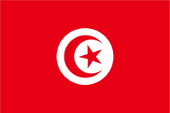 |
National-, Staats-, Handels- und Marineflagge – national, state, merchant and naval flag, Seitenverhältnis – ratio = 2:3, Quelle/Source, nach/by: Flags of the World |
 |
Gösch – naval jack, Seitenverhältnis – ratio = 1:1, Quelle/Source, nach/by: Flags of the World |
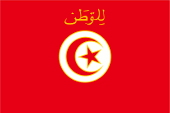 |
Flagge des Präsidenten – flag ot the President, Seitenverhältnis – ratio = 2:3, Quelle/Source, nach/by: Flags of the World |
historische Flaggen – historical Flags: |
|
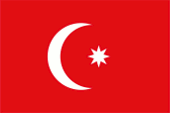 |
1793–1827, Flagge des Osmanischen Reiches – flag of the Ottoman Empire, Quelle/Source, nach/by: Wikipedia (EN)  |
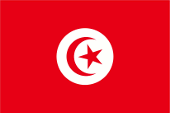 |
1827–1881, |
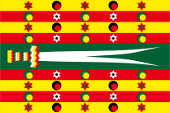 |
ca.1880–1957, |
 |
1881–1956, Protektorat – Protecorate, |
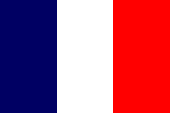 |
1881–1956, Protektorat – Protecorate, |
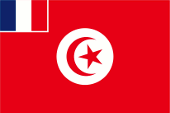 |
1881–1956, Protektorat – Protecorate, |
 |
1956–1999, |
| Die Flagge Tunesiens entstand irgendwann zwischen den Jahren 1827 und 1831 nach dem Vorbild der Flagge des Osmanischen Reiches (Türkei), unter dessen Oberhoheit das Gebiet des Bey von Tunis damals stand. Im Gegensatz zur Flagge des Osmanischen Reiches sind Halbmond und Stern auf der tunesischen Flagge rot und liegen auf einer weißen Scheibe in der Mitte eines roten Fahnentuchs. Die Gründe für diese Art Gestaltung liegen im Dunkeln und waren selbst für die Türken in der damaligen Zeit ein Rätsel. Der türkische Sultan soll mehrmals angefragt haben, was es mit der Flagge auf sich habe, soll jedoch nie eine vernünftige Antwort erhalten haben. Heute wird behauptet, dass das weiße Kreisfeld die Sonne symbolisiere und die Einheit des Landes verkörpere. Das Rot steht angeblich für das im Freiheitskampf vergossene Blut. Der Farbton des Rot scheint definiert, es lässt sich eine Angabe finden: Hexadezimal #E30A17. Daraus lässt sich ein Pantone-Farbton ableiten: Pantone 1788 c. Die Flagge wurde auch in der Zeit als französisches Protektorat beibehalten, jedoch musste sie an Land neben der französischen Trikolore gehisst werden. Nur auf See wurde die tunesische Flagge durch die französische Trikolore im Obereck ergänzt. Die Flagge des Bey zeigte acht rote und gelbe mit Halbmonden und Sternen bedeckte Streifen und in der Mitte einen breiten grünen Streifen. Darin das zweischneidige Schwert von Ali, dem Cousin und Schwiegersohn des Propheten Mohammed. Bemerkenswert ist noch die heutige Flagge des Präsidenten, wahrscheinlich für seine Funktion als Oberbefehlshaber der Streitkräfte. Einige Abbildungen zeigen sie mit der Inschrift "Li-l-watan", was so viel bedeutet wie "Für die Nation". Fotos zeigen einen schmalen goldenen Rand um die Scheibe und um Halbmond und Stern. |
The flag of Tunisia was
created sometime between 1827 and 1831, and was modeled on the flag of the
Ottoman Empire (Turkey), under whose sovereignty the area of the Bey of
Tunis was at that time. In contrast to the flag of the Ottoman Empire, half-moon and star are are red on the Tunisian flag and lie on a white disc in the center of a red bunting. The reasons for this type of design are obscure and were a mystery even to the Turks at the time. The Turkish Sultan is said to have asked several times what the flag was about, but was never given a reasonable answer. Today it is claimed that the white circular field symbolizes the sun and embodies the unity of the country. The red supposedly represents the blood shed in the fight for freedom. The colour-shade of the red seems to be defined; an indication can be found: Hexadecimal #E70013. A Pantone colour can be derived from this: Pantone 1788 c. The flag was retained during the period as a French protectorate, but it had to be flown on land next to the French tricolor. Only at sea was the Tunisian flag supplemented by the French tricolor in the upper corner. The Bey's flag featured eight red and yellow stripes covered with crescents and stars and a broad green stripe in the middle. Inside is the double-edged sword of Ali, the Prophet Mohammed's cousin and son-in-law. The current presidential flag is also noteworthy, probably for his role as commander in chief of the armed forces. Some images show them with the inscription "Li-l-watan", which means "For the Nation". Photos show a narrow golden border around the disk and around the half-moon and star. |
|
Quelle/Source:
Flags of the World, Wikipedia (EN), World Statesmen, Die Welt der Flaggen, Flaggen Wappen Hymnen, Flaggen und Wappen der Welt, Volker Preuß |
|
Wappen – Coat of Arms: |
|
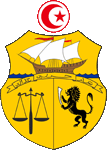 |
seit/since 1989, Wappen von Tunesien – coat of arms of Tunisia, Quelle/Source, nach/by: Wikipedia (EN), Corel Draw 4 |
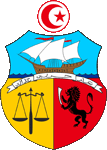 |
1963–1989, Wappen von Tunesien – coat of arms of Tunisia, Quelle/Source, nach/by: Wikipedia (EN), Corel Draw 4 |
| Das heutige Staatswappen Tunesiens wurde am 30.05.1963 eingeführt, damals noch als Farbdarstellung. Das Schild ist – auch heute noch – halbgespalten und geteilt, so dass drei Felder enstehen. Das obere Feld zeigt eine punische Galeere, das linke, goldene Feld eine schwarze Waage und das rechte rote Feld einen schwarzen Löwen mit einem Krummschwert. Sie symbolisieren Gerechtigkeit und Ordnung. Direkt über dem Schild der Wahlspruch: "Ordnung, Freiheit, Gerechtigkeit". Oberhalb des Schildes eine rot umrandete weiße Scheibe mit den Symbolen der Flagge: roter Halbmond und Stern. Es zeigt in der offiziellen Version einen goldenen Schild, in der Praxis werden die Felder des Schildes farbig dargestellt. Im Jahre 1989 wurde das Wappen verändert, indem die farbigen Hintergründe der drei Felder alle in einfarbig Gold umgefärbt wurden. |
The today's national coat
of arms of Tunisia was introduced on 30th of May in 1963, at that time still
as a coloured representation. The shield is – even today – vertically halved
and horizontally halved, creating three fields (semi parted per fess and
semi parted per pale). The upper field shows a Punic galley, the left,
golden field shows a black scale and the right red field shows a black lion
with a curved sword. They symbolize justice and order. Directly above the sign is the motto: "Order, Freedom, Justice". Above the shield is a white disc with a red border and the symbols of the flag: red crescent and star. In the official version it shows a golden shield, in practice the fields of the shield are shown in color. In 1989 the coat of arms was changed by changing the colored backgrounds of the three fields to solid gold. |
| Quelle/Source: Wikipedia (EN), Flaggen Wappen Hymnen | |
Flugzeugkokarde – aircraft roundel: |
|
 |
Flugzeugkokarde – aircraft roundel Quelle/Source, nach/by: Wikipedia (EN) |
Landkarte – Map: |
Lage – Position: |
Landkarte des Landes – Map of the Country: |
|
|
| Zahlen und Fakten – Numbers and Facts: | |
|
|
|
|
|
|
|
|
|
|
|
|
|
|
|
|
|
|
|
5000 v. Chr.
· Besiedlung durch Berber 1101 v. Chr. · Gründung von Utica durch die Phönizier 814 v. Chr. · Gründung von Karthago durch die Phönizier ca. 700 v. Chr. · Herausbildung des Karthagischen Reiches 264–146 v. Chr. · Kriege gegen das Römische Reich (Punische Kriege) 146 v. Chr. · Zerstörung Kathagos durch die Römer, Schaffung der Römischen Provinz Africa, Römische Besiedlung 395 · bei der Teilung des Römischen Reiches kommt die Provinz Africa an das Weströmische Reich ab 400 · Christianisierung 439 · Eroberung durch germanische Vandalen und Alanen, Gründung des Vandalenreiches 533 · Eroberung durch das Oströmische Reich (Byzanz) 647–698 · Eroberung durch die Araber mit anschließender Islamisierung, aus "Africa" wird "Ifriqiya" 800 · Kalif Harun ar-Raschid übergibt Ifriqiya an Emir Ibrahim ibn Al-Aghlab, Gründung der Aghlabiden-Dynastie 909 · Ubaid Allah al-Mahdi proklamiert sich zum Kalifen, Sturz der Aghlabiden, Gründung der Fatimiden-Dynastie 909 · Tunis wird erstmals Landeshauptstadt ca. 980 · der Fatimiden-Kalif Abu Tamim al-Muizz übergibt Ifriqiya an Buluggin ibn Ziri, Gründung der Ziriden-Dynastie 1057 · Sturz der Ziriden durch die Fatimiden 1159 · Eroberung durch den Almohaden-Sultan Abd al-Mumin 1228 · Abu Zakariya Yahya I. löst sich von den Almohaden, Gründung der Hafsiden-Dynastie, Ifriqiya wird ein eigenständiger Staat mit Tunis als Landeshauptstadt 1534 · Admiral Khair ad-Din Barbarossa erobert Tunis für das Osmanische Reich 1535 · Spanische Truppen erobern Tunis 1574 · Turgut Reis erobert Tunis für das Osmanische Reich, Tunesien wird Provinz des Osmanischen Reichs 1590 · Soldatenrevolte, Inthronisierung eines Bey als lokalen Herrscher, Tunesien muss jedoch die Osmanische Oberhoheit anerkennen und zahlt Tribut 1612 · Inthronisierung der Dynastie der Muraditen unter Murad Bey 1705 · Umsturz, Inthronisierung der Dynastie der Husainiden unter Husain I. Ibn Ali Bey 1861 · Verfassung, konstitutionelle Monarchie 1869 · Staatsbankrott 1871 · das Osmanische Reich verzichtet auf seine jährlichen Tributzahlungen 1880/81 · Plünderungen tunesischer Krumirs in Französisch-Algerien April 1881 · Einmarsch französischer Truppen 12.05.1881 · Bey Muhammad III. al-Husain unterzeichnet den Bardo-Vertrag, Tunesien wird französisches Protektorat April 1938 · anti-französische Unruhen 1939–1945 · Zweiter Weltkrieg; 1940: Tunesien verblieb unter der Kontrolle des mit dem Deutschen Reich verbündeten Frankreich, 1942: Tunesien wird durch in Algerien gelandete US-amerikanische Truppen bedrängt. November 1942: Stop des Vorrückens der US-Amerikaner durch Gegenangriffe deutscher Truppen bis April 1943. 13.05.1943: Kapitulation der deutschen und italienischen Truppen am Cap Bon bei Tunis. 1953 · anti-französische Unruhen 1955 · Frankreich gewährt Tunesien Autonomie 20.03.1956 · Frankreich gewährt Tunesien die Unabhängigkeit 25.07.1957 · Absetzung des Bey, Abschaffung der Monarchie, Tunesien wird Republik 1963 · Frankreich zieht seine letzten Truppen ab 1963 · Ein-Parteien-System 1963–1969 · vorübergehende sozialistische Politik 1969 · wirtschaftliche Probleme, Unruhen 1983 · Unruhen 1987 · Reformen, Zulassung anderer Parteien 2002 · neue Verfassung |
|
5000 B.C.
· settlement by Berbers 1101 B.C. · foundation of Utica by the Phoenicians 814 B.C. · foundation of Carthago by the Phoenicians ca. 700 B.C. · evolution of the Empire of Carthago 264–146 B.C. · wars against the Roman Empire (Punic Wars) 146 B.C. · demolition of Carthago by the Romans, creation of the Roman province of Africa, Roman settlement 395 · at the partition of the Roman Empire the Province of Africa comes to the West Roman Empire ab 400 · christianization 439 · conquest by teutonic Vandals and Alans, establishment of the Empire of the Vandals 533 · conquest by the East Roman Empire (Byzantium) 647–698 · conquest by the Arabs with following islamization, the name changes from "Africa" to "Ifriqiya" 800 · Calif Harun ar-Raschid hands Ifriqiya over to Emir Ibrahim ibn Al-Aghlab, establishment of the Aghlabid's dynasty 909 · Ubaid Allah al-Mahdi proclaims hisself to Calif, overthrow of the Aghlabids, establishment of the Fatimid's dynasty 909 · Tunis becomes capital for the first time ca. 980 · the Fatimide Calif Abu Tamim al-Muizz hands Ifriqiya over to Buluggin ibn Ziri, establishment of the Zirid's dynasty 1057 · overthrow of the Zirids by the Fatimids 1159 · conquest by the Almohad's Sultan Abd al-Mumin 1228 · Abu Zakariya Yahya I. unties hisself from the Almohads, establishment of the Hafsid's dynasty, Ifriqiya becomes an individual state with Tunis as capital 1534 · Admiral Khair ad-Din Barbarossa conquers Tunis for the Ottoman Empire 1535 · Spanish troops conquer Tunis 1574 · Turgut Reis conquers Tunis for the Ottoman Empire, Tunisia becomes a province of the Ottoman Empire 1590 · soldier-revolt, enthrone of a Bey as local sovereign, but Tunisia has to recognize the Ottoman supremacy and has to pay tributes 1612 · enthrone of the Muradit's dynasty under Murad Bey 1705 · overthrow, enthrone of the Husainid's dynasty under Husain I. Ibn Ali Bey 1861 · constitution, constitutional monarchy 1869 · bankrupt of the state 1871 · the Ottoman Empire renounces for its yearly tributes 1880/81 · pillages in French-Algeria by Tunisian Krumirs April 1881 · invasion of French troops 12th of May 1881 · Bey Muhammad III. al-Husain signs the Bardo-Treaty, Tunisia becomes a French protectorate April 1938 · anti-French agitations 1939–1945 · Second World War; 1940: Tunisia remained under control of the with the German Empire allied France, 1942: Tunisia becomes besieged by in Algeria debarked US-american troops. November 1942: stop of the advance of the US-Americans by counterstrikes of the German troops until April 1943. 13th of May in 1943: capitulation of the German and Italian troops at Cape Bon near Tunis. 1953 · anti-French agitations 1955 · France grants autonomy to Tunisia 20th of March 1956 · France grants independence to Tunisia 25th of July 1957 · deposition of the Bey, abolition of monarchy, Tunisia becomes a republic 1963 · France withdraws its last troops 1963 · single party system 1963–1969 · transitional socialistic policy 1969 · economic difficulties, agitations 1983 · agitations 1987 · reforms, permission of other parties 2002 · new constitution |
| Quelle/Source: Atlas zur Geschichte, Wikipedia (D), World Statesmen, Discovery '97, Volker Preuß |
| Die Landesbezeichnung "Tunesien" geht auf den Namen der Stadt "Tunis" zurück. Tunis ist eine sehr alte Stadt, die schon 1.000 v.Chr. existierte. Die Stadt wurde einst nach der phönizischen Göttin "Tanith" benannt. Tanith heißt "Schlangendame". Jedoch stand sie immer im Schatten des benachbarten Karthago. Nach dem Untergang Karthagos wurde das Land als römische Provinz "Africa" genannt, nach der Eroberung durch die Araber wurde daraus "Ifriqiya". Ab dem 13. Jahrhundert war Tunis die Hauptstadt der ganzen Region. Das blieb auch nach der Eroberung durch das Osmanische Reich im Jahre 1574 so. Allerdings kam es schon 1590 zu einer Soldatenrevolte, welche die Inthronisierung eines Bey als lokalen Herrscher zur Folge hatte; das wurde zum Beylik von Tunis (Türkisch: Tunus Beyliği), musste jedoch die Osmanische Oberhoheit anerkennen und zahlte Tribut. Mit dem wachsenden europäischen Einfluss wurde "Tunesien" als Landesname verwendet, wenn man so will bis heute, obwohl das Land offiziell "Tunesische Republik" genannt wird. Wortwörtlich heißt das Land aber "Al-Dschumhūriyya at-Tūnisiyya" → "Tunisische Republik". |
The country's name
"Tunisia" comes from the name of the city "Tunis". Tunis is a very old city,
dating back to 1.000 B.C. existed. The city was once named after the
Phoenician goddess "Tanith". Tanith means "serpent lady". However, it was
always overshadowed by neighboring Carthage. After the fall of Carthage, the
country was called "Africa" as a Roman province, and after the Arab
conquest it became "Ifriqiya". From the 13th century, Tunis was the capital
of the entire region. This remained the case even after the Ottoman Empire
conquered it in 1574. However, as early as 1590 there was a soldier's revolt, which resulted in the enthronement of a Bey as local ruler; the country became the Beylik of Tunis (Turkish: Tunus Beyliği), but had to recognize Ottoman suzerainty and paid tribute. With the growing European influence, "Tunisia" was used as the country's name, if you will, until today, although the country is officially called the "Tunisian Republic". The country's literal name is "Al-Jumhūriyya at-Tūnisiyya" → "Tunisian Republic". |
| Quelle/Source: Atlas der wahren Namen, Volker Preuß | |